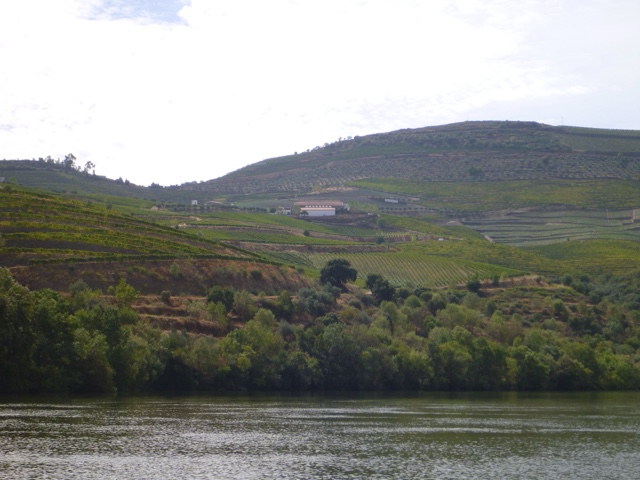With Eric's healthy interest in wine and my enjoyment of his interest a trip to Portugal would not be complete without a visit to the Douro Valley. This is the birthplace of port wine and it's ever changing terrain has been sculpted by centuries of very hardy farmers. The 50 mile stretch of river on either side of Pinhao is home to 4000 vintners and scores of Quintas or vineyards that produce port, table wines,and olive oils. The scenery was totally different than anything we had seen before with whole hillsides literally terraced into vineyards separated by rows of olive and sometimes almond trees. White houses with red slate roofs were situated here and there along the hillside to complete the picture. Scenic drives, a lazy boat trip and a couple of wine tours and tastings with some excellent meals made this a very worthwhile stop.
Some of the vineyards were very manicured while others looked very haphazard though I am sure they had a plan in their layout.
Most of the work on the side of the hills is done by hand as working with machinery is very dangerous as one can see by the precarious angle of this tractor.
We took a cruise down the Douro River in this little boat to view the vineyards from below. It was a lovely couple of hours and especially nice when the captain opened a bottle of wine to enjoy as we took in the scenery.
Some of the terracing was very steep and the vines were often interspersed with olive trees to increase the productivity.
No piece of land is wasted and the land is often passed down in families for many generations.
We stopped at DOC restaurant on the Douro to enjoy an amazing lunch before setting off for a wine tour and tasting.
Our visit coincided with the middle of harvest time so many vines were still heavy with grapes. All of the grapes are hand picked so it is quite labour intensive.
At Quinta do Vallado which is a family owned winery owned by the same family for three hundred years all the grapes are sorted by hand to assure that the lesser quality are not used.
Part of the grape production line
Though this winery still stomped some grapes that was reserved for ports and the rest were done in these large vats.
The bar across the top of the vat has been developed to duplicate the action of human stompers. Stomping is used for ports as the human foot is softer and gentler on the grape skins.
Large port vat down in their cellar
Looking at the vineyards from a higher viewpoint.
The Douro River and the view from our room as was the above picture. These vines in the foreground belong to the hotel as it seems everyone grows grapes and olives.
The windmills in the distance are for generating power and as we left the Douro Valley we saw large farms of them. Clean power but I am sure many birds would disagree.
Pickers working in the hot sun to harvest the grapes.
Grapes are transported in small trucks as they are carried off the hills by the pickers. Hard work for apparently not much pay.
The second winery we visited was Quinta da Pacheca and also does so much by hand
These grapes were going into a crusher and were then carried by a large hose to a stomping tank.
These stomping tanks are made of granite and I was more than a little surprised to find out that this method is still used quite extensively in Portugal.
Though this was a photo pose the stomping is very tedious and regulated by the wine maker. On the first night after the vat has been filled stompers will join together as above right across the tank and walk back and forth slowly in unison for up to four hours. This night is quite somber and little is said. On the second night of stomping it is much more random and there is often music and dancing involved. For some ports up to four nights of stomping is required.
We enjoyed a delightful lunch in the restaurant of the winery sharing a traditional Portugese dish of duck rice. Absolutely delicious.
Unusual to see vines on a flat piece of land in the Douro Valley.

























No comments:
Post a Comment